Son free son
Médiane Co.
Created for the Premières Rencontres 2014
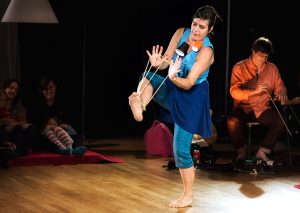
A show of knitted music for toddlers and their families. With a couple of lovers and a few musical notes. She sings… He makes the strings vibrate. A step towards him… a note towards her. The music of glances is sketched out, runs along the woolen threads, hesitates then swells until it carries us away in a great musical hug. Son free Son is a musical show for toddlers and their families, a first artistic experience to be lived together comfortably installed in the hollow of cushions and arms, where love takes the path of notes gathered in solo, in duet, to reach the choir… in the heart… So true is it that we need the other to grow.
Conception, direction: Catherine Sombsthay
Conception, song, acting: Emmanuelle Zanfonato
Conception, music, acting: Bertrand Sombsthay
Stage design collaboration: Thierry Cadin, Pierre Gattoni, Dominique Hardy, Quentin Charrois
Photo graphic designer: Bart Kootstra
Coproductions : Espace Culturel de Vendenheim, Graines de spectacles Clermont-Ferrand, City of Schiltigheim, TJP Centre Dramatique National d’Alsace Strasbourg. Supporters : DRAC Alsace, City of Strasbourg, Région Alsace, Conseil Général du Bas-Rhin, Communauté de Communes de Berstett.
This show, produced by La Compagnie Médiane, was supported by the Conseil Général du Val d’Oise as part of the Premières Rencontres 2014.
The feature
Lampshades that cast a subdued light over our heads, four large sofas where we snuggle up to each other, cushions that embrace us: we are the pampered guests of a tender couple who come to tell us how human relationships are woven with little things. He is a musician, calm, gentle, composed. She is a singer, mischievous, sensual, lively. He looks at her, listens to her and accompanies her in her games of approach and construction of a love nest that will become ours. With the simplest objects, wool threads, plastic cups, cans and pieces of wood, this loving couple gradually transforms their small living room into a sound, musical and colourful cocoon. We are with them, inside, protected by an architecture of crossed threads, ready to slip into the arms of Morpheus. Go to sleep, go to bed, oh baby” she sang to us when she welcomed us. Without fear, without crying, we enter the night together with only a small lantern that lights up our woolen ceiling like little stars. This meticulously written show leaves nothing to chance: gestures, exchanged glances, little bits of wool manipulated, voices and sounds are the rigorously chosen and arranged components of a journey that takes us from day to night, from visible to invisible. A beautiful first approach for the very young to the mystery of what connects us to each other.
Dominique Duthuit
Caminos/Chemins
Titeres de Maria Parrato Co.
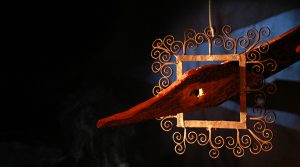
Objects, pieces of wood, stones, smoke, drops of water.
In the air at the end of a fishing rod, a wrought iron frame swings.
This is the place of suspended time where the objects appear.
These objects, on entering the frame, undergo a transformation, and, from that moment on, time stretches…
Actor: Maria Jose Frias
Direction: Carlos Laredo
Artistic direction and production: Titeres de Maria Parrato
The feature
We are in a sort of dark cave where all our senses are heightened: sounds resonate, objects are projected into mysterious figures, our vision is blurred by the smoke of an incense stick. A woman in a grey apron is the mistress of this place, a bit of a witch, a bit of a magician. Alone, very concentrated, she manipulates basins and water, wood and stones, nails and scrap metal boxes, dried squash, dead leaves and apples to combine them, transform them, give them a second life. Very animal, her approach to matter is sensory: she sniffs, touches, tastes and accompanies each of her gestures with a voice that seems to come from her entrails, breaths, rales, cries, songs. In a permanent mystery, in a suspended time, she makes strange and familiar forms emerge from her objects. Caminos (“paths” in Spanish) is a journey to the land of dreams that takes the very young through the seasons and the impermanence of the world.
Dominique Duthuit
Paradéïsos
AMK Co.

What if Paradise existed on earth, thanks to such a quality of exchange that we could rethink everything: the earth, ourselves and others?
“Paradéïsos” is the choreographed dream of a harmonious ecosystem, offering children a joy of living, in the heart of an Iceland populated by small dancing beings. Wonder, metamorphosis, hatching, giving birth. These vital forces take shape in a gentle swirl of cycles, punctuated by the magic of an object that gradually unfolds its multiple facets.
Animated images, music, songs, dance and sculptures are articulated in three gardens of delights, three spaces to offer ourselves here below the time of a new Genesis.
Conception, stage design and video direction: Cécile Fraysse
Live music: Alexandre Lévy
Dance: Valentine Paley
Post-production and animation collaborator: Frédéric Poulain
Lighting design: David Boots
Co-production Espace Boris Vian, scène conventionnée jeunes publics des Ulis, Espace Périphérique La Villette, festival Petits Bonheurs/Les Casteliers à Montréal (Québec).
Creation residencies : La NEF à Pantin, Espace Germinal à Fosses, Espace Périphérique La Villette / Partners : Festival Fontenay en Scènes, Centre Culturel de Persan, Théâtre Dunois Paris, Compagnie ACTA through the PREMIERES RENCONTRES.
With the support of the Conseil Général du Val d’Oise. The AMK company is supported by the DRAC Ile de France and the Ile de France Region.
The feature
Paradise is not a utopia, it is a reality that is within our reach, it is built within ourselves and in the encounter with the outside world. From this beautiful and reconciling idea, inspired by Séverine Auffret’s work “Aspects du paradis”, Cécile Fraysse weaves the thread of a sensory, mental and emotional journey that opens up the possibilities of creating a paradise. And it takes shape before our eyes, progressively, from a great diversity of scenic materials that are both palpable and impalpable, familiar and magical, domesticated and wild. Everything is there so that everyone can come and invent an imaginary and fertile land: the sound, the light, the material and a dancer, an incarnation of ourselves, who will be born and act in tune with an environment in perpetual movement. The stage is a sort of matrix that nourishes our senses, our emotions and our ability to dare to move. We hear the earth cracking and the torrents flowing, we see on the big screen the wild landscapes of Iceland where ice and fire clash, we listen to children’s voices speaking to us of happiness, fear and love, we meet strange little creatures that come to live in nature… Without obviously being the high priestess who knows the keys to happiness, the director immerses us in a territory where the founding elements of life are brought together, as much those that we master as those that are beyond us. All that remains is for the children in the audience to make their honey out of all this material and draw from it the energy of life. “Paradéïsos” says Cécile Fraysse, “is a new land in the making, between paradise and hell. It has as many faces as there are spectators, everyone can project themselves into it and move around freely. At the end of the show, each child leaves with a small seed that will be the beginning of a small paradise garden to share.
Dominique Duthuit
Dal Vivo
Flop Lefebvre
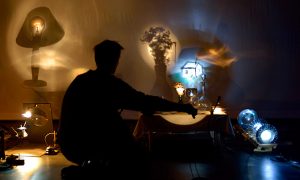
Construction, “dal vivo! / sur le vif!”, of a light painting.
From an old-fashioned device, manipulated and lit entirely on sight, a living and fragile image appears on the wall. An ephemeral painting in which light particles replace pigments. The “witness painting” of a moment in which reflections, shadows, blur and sharpness are organised according to attempts and accidents into an empirical and poetic composition. A performance on gesture and light for all audiences from a very young age.
Conception and interpretation: Flop Lefebvre
Photo credit: Jef Rabillon
Co-production Le Channel, Scène Nationale de Calais – A.T.H. Associés, Lili Désastres.
The feature
Flop is a filmmaker without a camera or film, who seeks to give the most familiar objects a second chance to exist. By trusting in randomness and accident, he illuminates them so that they are projected and revealed on the big screen in a form that he did not know existed. A craftsman of the little, he places on the floor small, well-chosen things that he likes (bouquet, candle, dried flowers, glass, etc.) and he arms himself with the most rudimentary tools to better succeed in metamorphosing them: lenses, mirrors, slides, bits of tape hung here and there, small homemade mechanisms. Then, a bit like a cat, he slowly moves around, approaches each object and directs the beam of his lamp onto it. From frozen still lifes, they become shadows charged with a vibrant energy. In a perpetual and always unexpected movement, punctuated by the sound of the cogs of his fragile machines, the shadows are coloured, faded, metamorphosed, and linked to each other to compose incessant landscapes that end up merging into the cosmos. Looking at the canvas, as in the cinema, we go on a journey to another world where everyone, child and adult, can tell their own story. It is simply magical!
Dominique Duthuit
Petit Câlin
Dance Theatre Auraco

The dance performance Petit Câlin is like a gentle embrace where the audience is invited to concentrate and relax, to laugh, to cry, to be very serious; where there is room to desire and to be comforted. The idea and the name of the piece come from the French expression “petit câlin”, which corresponds to the way of holding a newborn baby in one’s arms. The play of movement with a space limited by a rope on the floor, the voice and the lights transport the audience from one emotion to another.
Concept and direction: Päivi Aura
Choreography: Päivi Aura, Takako Matsuda
Music: Philippe-Marcel Iung
Lighting: Keijo Vainio Costumes : Piritta Kämi-Conway
Dancer: Takako Matsuda
Musician: Philippe-Marcel Iung
Photos: Rene Korpela
Poster: Keanne van de Kreeke
Production : Dance Theatre Auraco
The feature
On an empty stage, on which a small rope is just left, a man and a woman talk. The man expresses himself through his voice, the woman through her body. She listens to him and without looking at him, she responds with a danced gesture. Sitting down at the beginning, in a waiting position, she stands up, moved by emotions and desires that dictate the movements of her body. Instinctively, she goes from almost animal agitation to the harmonious control of her gestures, passing through very short immobile postures. Her rhythms, her states, her positions (sitting, crawling, lying down, standing), her displacements, her minute or ample, jerky or fluid movements are constantly changing. She seems to be in search of comfort, of plenitude, perhaps. After multiple explorations of a territory she will never succeed in delimiting, she builds herself a little nest with the rope to soothe herself. This show is based on the expressive quality of Takako Matsuda’s gestures, a magnificent dancer who keeps the little ones on their toes. Concentrated, they share with this artist the taste and the need to find the satisfaction of being in the world.
Dominique Duthuit
Ho un punto fra le mani
Tam Teatromusica
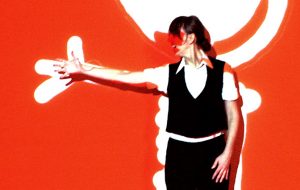
A body dialogues with the silence of a moving point in space, the poetry of a curved line evoking a smile. Accompanied by music, it immerses itself in an explosion of colours, both food and perfume… So many sensations to invite the little one to dive into this mirror of images.
Conception and direction: Flavia Bussolotto
Live digital design: Alessandro Martinello
Music: Michele Sambin
With Flavia Bussolotto
Production : Tam Teatromusica
The feature
The device is simple and playful: a woman stands in front of a white canvas on which a point of light is projected. The latter is naughty, unpredictable, mobile and transformable. It becomes a jumping ball, it multiplies, it disappears and reappears, it is the line that partitions or redraws the space. Will it let itself be caught and tamed? Each of its movements, each of its transformations is associated with the sounds of the cello, which also leads us into a multitude of sound possibilities. In the course of an ever more inventive graphic and musical score, living tableaux are created before our eyes. In two dimensions and then in three, they are inspired as much by cartoons as by surrealist paintings. With a high standard of writing, sounds and images unite in a rich and tasty dialogue. “Ho un punto fra le mani” is a jubilant show that crosses all the arts with glee: music, dance, painting, cinema, theatre. A source of wonder for the little ones.
Dominique Duthuit
Stoplicht (red light)
wiersma & smeets co.
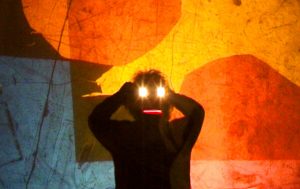
A little light-white man wants to see his friend, the little red light man. But it’s not easy and before they meet each other, they have a long journey through a strange country full of lights. A great adventure!
Why does the little man change his colour to red? Why does the little green man never want to stay in his place?
Idea and creation: Bram Wiersma & Moniek Smeets
Music: Bram Wiersma
Production : wiersma & smeets
The feature
The two Dutch artists Bram Wiersma and Moniek Smeets invite us into the heart of their workshop, a bric-a-brac of the most eclectic tools: electric wires, paper sheets, fabric, glass, fans, ingenious little mechanisms and numerous lamps scattered in every corner. It is a workshop of yesterday and today where the most elementary craftsmanship meets the most sophisticated technology. And from all this jumble of things, many funny and wonderful stories are born before our eyes. The thread that weaves them all together is a little man running, a character familiar to children who allows them to cross the road when the light is red. “Stoplicht is a light show,” says Bram Wiersman, putting two small lamps, one red and one green, into his pockets. But it is much more than a light show, it is a complete show that introduces children to abstract painting, animated film, shadow theatre and music. Their eyes and ears are constantly awake, constantly surprised by everything that can appear in front of us, above us and around us. Without posing as demiurges, the artists manipulate all their tools, projection systems and lamps of all kinds, leaving the power to the creation of images. They are the masters of the game, naughty, they appear, transform themselves and slip onto the artists’ bodies. It is with great joy and laughter that the light, never totally domesticated, always free and lively, takes us into a diversity of universes, from the most realistic to the most dreamlike, the last of which seems limitless…
Dominique Duthuit
La Campagne en secret
Les bruits de la lanterne Co.
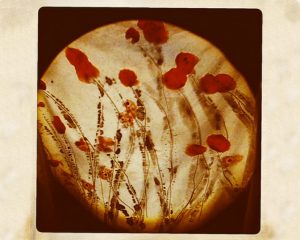
Large white cloth drapes are installed above and on each side of the stage, a small motorized object with a strong light intensity moves slowly and puts in shadow branches, grasses, flowers… a whole nature path.
In the pleasure of slowing down time, perceiving the day that rises, the night that sets in, listening to the song of a flowing river… taking the time to rest in front of these reconstituted beauties.
Poetry and music accompany this journey together.
Direction: Catherine Morvan and Jean-Claude Oleksiak
Actor, singer, object manipulator: Catherine Morvan
Musician: Jean-Claude Oleksiak
With the support of the Conseil Général de Seine Saint Denis, the Théâtre de Vanves, the MJC de Chilly Mazarin, the City of Neuilly sur Marne and the ACTA company as part of the PREMIERES RENCONTRES.
The feature
From the garden to the courtyard, on rails, the beam of a small lamp slowly travels across a large white fabric hanging from which the moving shadows of leaves, trees and flowers emerge. Jean-Claude Oleksiak and Catherine Morvan invite us on a contemplative journey to the heart of a mysterious nature. He is a composer and musician, she is a singer and artist. There is no real story in their show, the dramaturgic thread, if there is one, is the poems of François Cheng, words that tend to evoke the combined beauty of the world, nature and the human body.
Dominique Duthuit
So that the little ones can be lulled by their sounds, a universe on the border between the visible and the invisible is composed live before their eyes. In near darkness, they are drawn into the path of shadows created by magic lanterns, bright lanterns and old bicycle headlights. A simple branch or a fragile leaf is transformed into a secular tree or a pecking bird. In wonderment, they discover an impalpable representation of nature in eternal motion.
The sounds of the double bass, the flute, the rubbing of the stones, the phonemes, are all little touches of sound that open up our field of perception ever wider. We all, artists and spectators, enter an otherworldly world that is similar to a dream, an otherworldly world that everyone can freely appropriate.
Tic Tac Tic Tac
Casa Degli Alfieri Co.

Micro-narratives, small actions, delicate, whispered movements, without words. Stories punctuated by particular clocks that speak of past and present time. A simple scenography, a “fragile world” made of houses made of natural materials (branches, leaves, earth, seeds, snowflakes…), small lights and clocks, poems of tender, silent and sometimes clownish movements.
With: Antonio Catalano
Direction and stage design: Antonio Catalano
Technical manager: Matteo Catalano
Organisation and tour booking: Claudia Ponzone
Administration: Franca Veltro
Production casa degli alfieri – universi sensibili
The feature
After 34 years in the Italian theatre, where he practised street theatre, pantomime and official theatre, Antonio Catalano is now seeking to create a theatre of the encounter. A jack-of-all-trades, in perpetual research, a visual artist, a storyteller, a musician and a poet, he gives life to sensitive universes, close to raw art, which seek to awaken our capacity to know how to marvel at the simplest things. He works, as he says, “on childhood with childhood” in free improvisation, opening doors to imaginary worlds where everyone can get lost or find themselves, leaving their own traces. In this show created in 2011, he offers us to see micro-narrations, small actions, delicate, whispered movements, without words. Stories marked by particular clocks that speak of the passing of time and the time that is here. A simple scenography, a “fragile world” made of houses made of natural materials (branches, leaves, earth, seeds, snowflakes…), small lights and clocks that mark a poetic time without duration, made of tender, silent, sometimes clownish movements. So many possible ways of looking at everything around us with the little ones in an astonished way.
Dominique Duthuit
Le jardin sous la Lune
Praxinoscope Co.
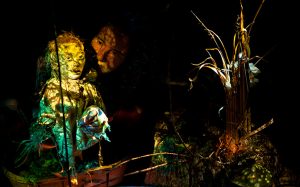
A garden in the half-light, under the moon, a real garden, a representation of the world in miniature with its geography, paths, moss, an old stump, a shrub. A garden for children, a space of freedom with musical instruments, poems, smells, a marvellous garden with luminous projections, apparitions of images on mists, water, sails, plant sculptures, micro-gardens suspended here and there as invitations to dream…
Creation and direction: Vincent Vergone with text from Marcelle Delpastre
Actors: Vincent Vergone or Emilie Pachot
Musicians: Marion Loraillère or Muriel Gastebois
Costumes : Amano Louis
Artist in residence at the Les Treize Arches – Nouveau Théâtre de Brive Cocreated with the Théâtre Dunois With the support of the Drac Ile-de-France, the Île-de-France Région, the Seine-Saint-Denis District, the Mairie de Paris, and the cities of Aubervilliers, Sevran, Stains, and Le Bourget, of the Théâtre de la Montagne Magique in Brussels, the Amin Theatre Company – Salle du Jardin planétaire and the Festival 1,9,3 Soleil. Selected by the Printemps des Poètes
The feature
Vincent Vergone, director, sculptor and image-maker, invites us into a miniature, dreamy garden that erases all borders. We are yesterday and today, here and elsewhere, in a landscape that has been built and is constantly being rebuilt from the five founding elements of the world: wood, fire, earth, metal and water. Sitting on small benches, inside a tent where it is dark and cool, we live in a territory where nature and culture blend harmoniously. All creations find their place, as much those of men: the stove to heat, the clock to organise the day, the kitchen utensils to feed oneself, as those of the plants, composite assemblages that hang above our heads. In the company of a musician, we explore in a sensory way the unsuspected richness of all that surrounds us: smells of earth, flowers, leaves, emission of soft sounds, listening to poems by Marcelle Delpastre, a peasant poet, and the gush of images projected by eight magic lanterns. A child is born in this little corner of paradise, a fragile puppet, a wild child who seems to know nothing of the codes of the civilised world. The whole thing ends in the multicoloured reflections of a wet mist that smells of orange blossom. For several years, Vincent Vergone has been working closely with early childhood professionals to make children and adults aware of the beauty of the world. By mixing the so-called learned arts (cinema, poetry, music, sculpture) with the so-called popular arts, he brings into the heart of everyday life spaces that are conducive to awakening the need and the taste for gardening our planet together.
Dominique Duthuit
Ōuli
Cincle Plongeur Co.
Ōuli means “nature” in Hawaiian. Metamorphosed into a half-animal, half-plant princess, choreographer Anne-Laure Rouxel sets off, to the rhythm of songs composed for the occasion by Julie Bonnie and the sounds of nature, to encounter this luxuriant diversity: its marvellous abysses, its dazzling heights, its vitality and its profusion of life.
It plays, learns to feed, to heal, to defend itself and to hide… it makes do with its splinters, the earthquakes, the storms…
She gives life, rests in the warmth of her family…
A journey of initiation where dance gives way to play, fantasy and ritornello.
Conception, choreography and interpretation: Anne-Laure Rouxel
Music and song composition and interpretation: Julie Bonnie (voice, violin and guitar)
Lighting: Franck Thévenon
Stage design: Patrick Genty
Costumes: Catherine Lourrioux
Production : Cie Cincle Plongeur with residency support from the Espace Malraux/ City of Joué les Tours (37). Cocreated with Théâtre du Beauvaisis. With creation support from the Direction Régionale des Affaires Culturelles Centre – Ministère de la culture et de la communication, the Conseil Régional de la Région Centre and the Conseil Général d’Indre et Loire et de la Spedidam.
The feature
Ouli, means “nature” in Hawaiian. This nature is not really represented on the stage, a hut, some foliage, and that’s it. No, it springs up and invades us through the danced gesture, the sound and the music. In duet, accompanied by a composite soundtrack of insects and birds, choreographer Anne-Laure Rouxel and musician and singer Julie Bonnie conjure up images that evoke the richness and mystery of nature. It is nature that nourishes, heals and protects, but it is also nature that threatens, attacks and frightens. As a hybrid creature, Anne-Laure Rouxel goes through all these states of emotions, instinctive and playful, fragile and curious, worried and daring. She is a small imaginary being who explores the world to draw vitality and strength from it. Gradually, her body transforms, she leaves her animal skin, is adorned with plants before taking on human form and becoming a protective young mother. It is a little story of the whole of humanity that is told here, from the day when there was only the land, the sea and the birds until the arrival of man… Who are we in this world? Without words, the answer is danced: the same as always!
Dominique Duthuit
La Caverna Sonora
La Casa Incierta
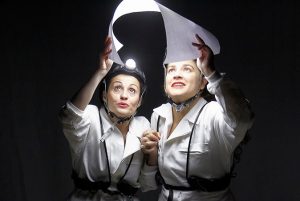
An actress, an opera singer and a pianist take us energetically on a poetic journey, an opera for adults, babies and very young children, together discovering the first stammerings, babblings, words and words. A journey through the throat, the cavity of the mouth and the skull, echoing the sensation that a toddler can feel when he tries to communicate even before verbalising.
Actors: Clarice Cardell, Maribel Per, Mikhail Studyonov
Costumes: Val Barreto
Music direction: Mikhail Studyonov
Dramaturgy: Carlos Laredo, Miguel Angel Mendo
Direction: Carlos Laredo
Created by : La Casa Incierta Co-production Ayuntamiento de Madrid, Teatro Fernán Gómez, La Casa Incierta
The feature
The hands of a pianist and two women dressed in white with their explorer’s headlamps take us to the origins of words and writing… the cradle of all humanity.
Agnès Desfosses
We received so much love (yes, we can say that word with regard to “La caverna sonora”) through the lyricism of the sung voices, the guttural research of the vowels and the bursting of the consonants on the edge of the lips; through a visual waltz of signs and archaic writings in a white space made mobile by the two interpreters.
Once the show was over, everyone, children, parents, children’s staff and programmers, sat there for a long time in front of the white calm… We needed this time to savour the time suspended by this show before returning to our daily lives and leaving the theatre.